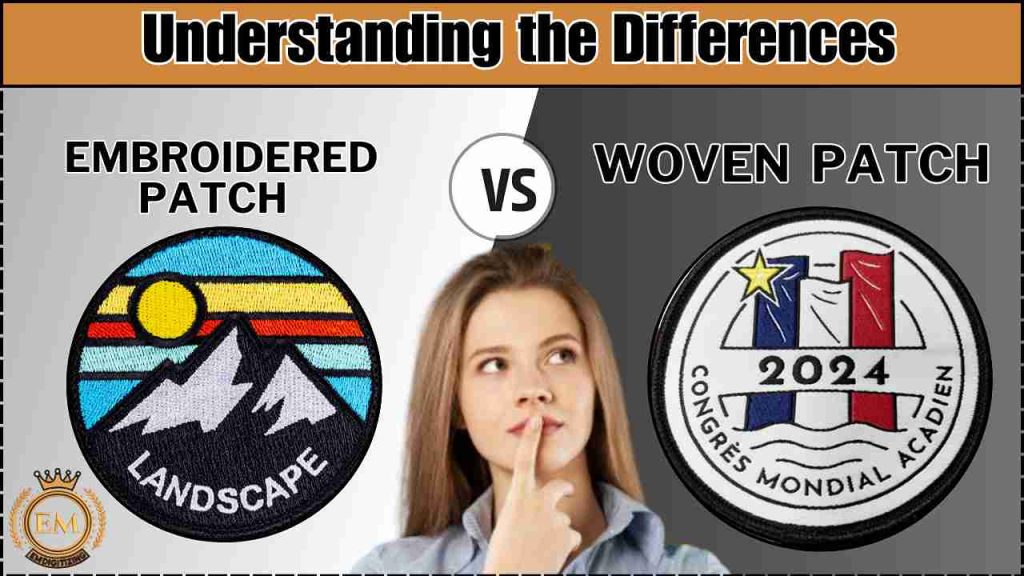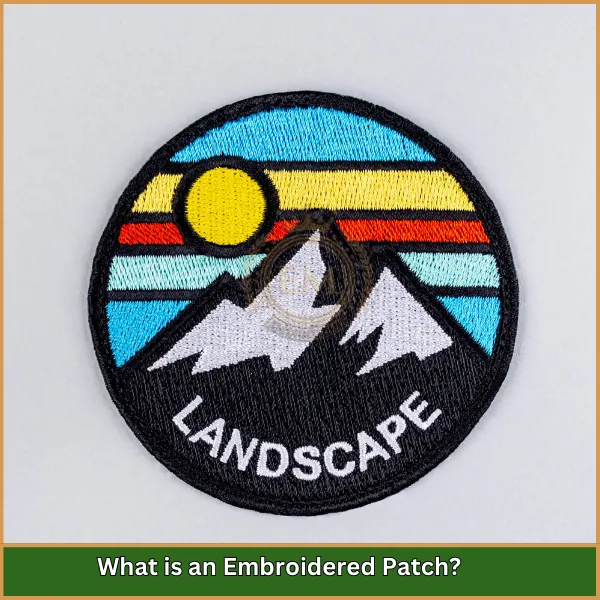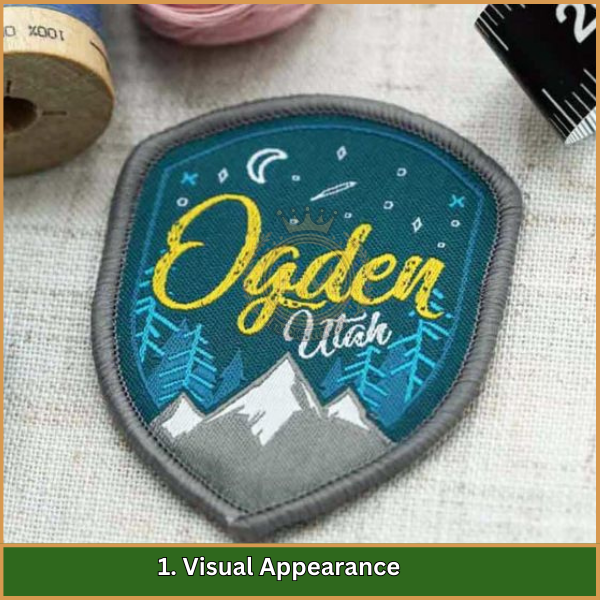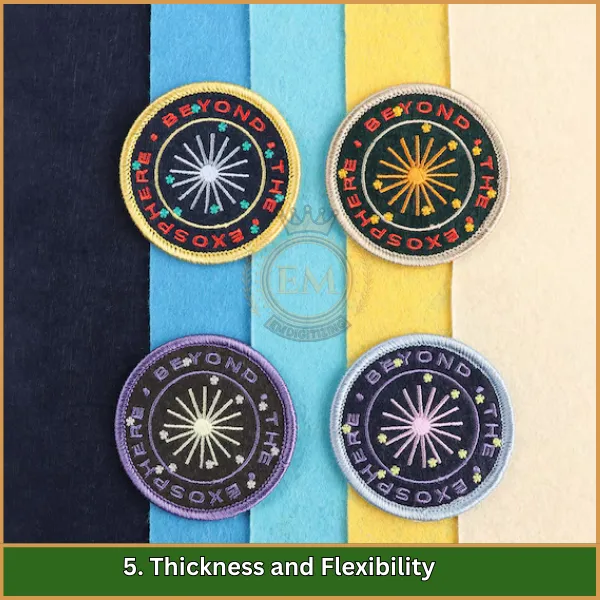Choisir entre un patch tissé ou brodé peut être déroutant si vous ne savez pas lequel correspond à vos besoins.. Les deux types de patchs sont populaires pour personnaliser les vêtements., Sacs, et uniformes, mais ils ont des looks et des avantages différents. Les patchs tissés sont parfaits pour les conceptions détaillées avec une finition lisse, tandis que les patchs brodés donnent un aspect plus classique, sensation texturée avec des coutures en relief.

Dans cet article, we’;Nous explorerons les principales différences entre les tissus tissés et patchs brodés, vous aider à comprendre lequel est le bon choix pour votre projet. Whether you’;re après la précision ou un gras, aspect traditionnel, ce guide clarifiera tout ce que vous devez savoir!
Patch tissé ou brodé: Comprendre les différences
Qu'est-ce qu'un patch tissé?

Il est fabriqué à partir de fils plus fins tissés ensemble pour créer un patch aux détails fins.. Ces correctifs utilisent une technique de tissage similaire à la création de tissu, qui permet des conceptions complexes et précises. Les fils sont étroitement tissés, ce qui se traduit par une finition lisse et plate. Contrairement à epatchs mbroidés, Les patchs tissés n'ont pas de points surélevés, leur donner une apparence plus propre et plus détaillée.
Avantages
- Détail fin: Idéal pour les conceptions avec des détails complexes, petit texte, ou images complexes, Comme le processus de tissage permet plus de précision.
- Texture lisse: La surface plane donne une élégante, aspect poli, qui est parfait pour les logos ou les œuvres détaillées.
- Mince et flexible: Généralement plus mince et plus flexible, Les rendre plus confortables à porter et plus faciles à coudre sur les vêtements.
- Durabilité: Longue durée, Et leurs créations ne s'estompent pas ou ne s'usent pas facilement au fil du temps.
Inconvénients
- Moins de texture: Manque de texturation, 3D effet que les correctifs brodés offrent, ce qui peut être moins attrayant pour ceux qui recherchent un look de patch plus traditionnel.
- Couleurs de fil limitées: Le processus de tissage peut limiter le nombre de couleurs de fil utilisées, ce qui rend difficile la réalisation de designs multicolores avec un ombrage parfait.
Qu'est-ce qu'un patch brodé?

Il est créé en cousant des fils sur un support en tissu pour former le motif.. Les fils sont surélevés au-dessus du matériau de support, donner au patch une texture, aspect tridimensionnel. Ces patchs sont souvent utilisés pour des designs simples et audacieux, logos, ou des symboles qui ne nécessitent pas de détails complexes. Ils sont un choix populaire pour les insignes militaires, logos d'équipes sportives, et uniformes.
Avantages
- Look classique: Offrir un traditionnel, aspect texturé, ce qui les rend idéaux pour les designs classiques ou les logos qui doivent se démarquer.
- Durabilité: Très durable et peut résister à l'usure, ce qui les rend adaptés à un usage intensif.
- Large gamme de couleurs: Peut incorporer une large gamme de couleurs de fil, Permettre dynamique, des designs accrocheurs.
- 3D texture: Les coutures surélevées crée un texturé, Effet dimensionnel qui ajoute de la profondeur au patch, lui donner une sensation plus substantielle.
Inconvénients
- Moins de détails: Pas adapté aux conceptions avec des détails fins ou un petit texte, Comme les fils épais utilisés dans la broderie peuvent rendre le design moins net.
- Plus volumineux: Les points surélevés et les fils plus épais les rendent plus volumineux et moins flexibles par rapport aux plaques tissées, qui peut ne pas être idéal pour certaines applications.
Principales différences entre les patchs tissés vs brodés
Lorsque vous décidez entre les patchs tissés par rapport aux patchs brodés, it’;s essentiel pour comprendre les principales différences. Chaque type de patch a ses forces et est mieux adapté à certaines conceptions ou à des fins.
- Apparence visuelle
- Détail et précision
- Texture
- Durabilité
- Épaisseur et flexibilité
- Gamme de couleurs
- Coût
1. Apparence visuelle

Les patchs tissés ont un aspect élégant et lisse grâce au processus de tissage, ce qui crée une surface plane. Cela rend les patchs tissés idéaux pour obtenir un nettoyage propre., regard vif, spécialement pour les logos ou les dessins avec des détails complexes.
En revanche, les patchs brodés ont un relief, surface texturée, leur donnant une apparence plus traditionnelle et audacieuse. Les points en relief de patchs brodés ajouter de la profondeur et de la dimension, les faisant ressortir davantage visuellement.
2. Détail et précision

Quand il s'agit de détail et de précision, les patchs brodés et tissés diffèrent considérablement. Les patchs tissés sont créés à l'aide de fils plus fins tissés étroitement ensemble., permettant des détails beaucoup plus fins. Cela rend les patchs tissés parfaits pour les designs nécessitant des illustrations complexes., petit lettrage, ou des traits délicats.
D'autre part, les patchs brodés utilisent des fils plus épais et sont cousus sur un support en tissu, ce qui limite la quantité de détails pouvant être inclus. Par conséquent, les patchs brodés conviennent mieux aux designs plus simples avec des lignes audacieuses et des éléments plus grands.
3. Texture

La texture des deux types de patchs est également assez différente. Les patchs tissés ont une surface lisse, texture plate due au processus de tissage, ce qui leur donne une finition raffinée et polie. Cette texture plate permet un look plus moderne et épuré.
En revanche, La comparaison entre patch brodé et patch tissé montre que les patchs brodés ont une surface texturée et surélevée en raison du processus de couture.. Les fils en relief donnent au patch un effet 3D, le rendant plus tactile et visuellement attrayant.
4. Durabilité
Les patchs tissés et brodés sont durables, mais les patchs brodés ont tendance à être légèrement plus robustes. Les fils épais utilisés dans les patchs brodés offrent une plus grande solidité et résistance à l'usure., ce qui les rend bien adaptés à un usage intensif, comme sur les uniformes, Sacs, ou des vestes.
Patchs tissés, tout en étant durable, sont généralement plus minces et peuvent ne pas résister aussi bien à une utilisation intensive constante. Cependant, pour un usage quotidien ou à des fins décoratives, les patchs tissés offrent une durabilité suffisante.
5. Épaisseur et flexibilité

Les patchs tissés sont généralement plus fins et plus flexibles que les patchs brodés. La construction tissée leur permet de reposer à plat contre le tissu, les rendant plus confortables à porter, surtout sur les vêtements. Leur flexibilité les rend également plus faciles à coudre sur les vêtements.
En revanche, les patchs brodés sont plus volumineux en raison des points en relief. Cette épaisseur supplémentaire peut les rendre moins flexibles et paraître plus lourds lorsqu'ils sont attachés au tissu.. Pour les conceptions nécessitant un patch plus léger et plus flexible, les patchs tissés sont souvent le meilleur choix.
6. Gamme de couleurs
En comparant les options de couleur, les patchs tissés peuvent avoir certaines limites. Le processus de tissage utilise des fils plus fins, ce qui peut rendre difficile l'incorporation de plusieurs couleurs dans un design. Cependant, les patchs tissés peuvent toujours produire des couleurs propres et éclatantes, juste avec moins d'options d'ombrage et de dégradé.
D'autre part, les patchs brodés offrent une plus large gamme de couleurs. Le processus de broderie permet d'utiliser plus de couleurs de fil, permettant de créer des designs plus complexes et colorés. Cela rend les patchs brodés idéaux pour les designs qui nécessitent des couleurs vives., des couleurs accrocheuses.
7. Coût
En termes de coût, les patchs tissés ont tendance à être plus abordables que les patchs brodés. Le processus de production des patchs tissés est généralement plus simple et plus rapide, ce qui réduit le coût global. Cela fait des patchs tissés une option économique pour les designs qui nécessitent une haute précision mais n'ont pas besoin de la texture supplémentaire de la broderie..
Patchs brodés, toutefois, sont généralement plus chers en raison de la main-d'œuvre processus de couture et l'utilisation de matériaux plus épais. Le travail détaillé impliqué dans la création de la texture en relief des patchs brodés ajoute au coût de production, mais cela donne également un patch plus durable et visuellement plus frappant..
Conclusion
Quand il s'agit de choisir entre un patch tissé ou brodé, it really depends on the look you’;je vais pour. Les patchs tissés sont parfaits pour les conceptions détaillées avec une finition lisse, tandis que les patchs brodés vous donnent un style plus audacieux et traditionnel avec des coutures en relief.
Chez EMDigitizing, nous pouvons vous aider à créer le patch parfait avec notre services d'art vectoriel. Nous offrons un délai d'exécution rapide, prix abordables, et fournissez toujours des résultats de haute qualité. Et si c'est la première fois que vous travaillez avec nous, tu auras un 50% remise sur votre première commande.
Faisons ressortir vos correctifs personnalisés avec EMnumérisation!
FAQ
Les patchs tissés sont fabriqués en tissant des fils ensemble pour créer un motif., permettant des détails plus fins et une apparence plus plate, tandis que les patchs brodés sont cousus sur un support en tissu, en leur donnant une augmentation, aspect texturé.
Les patchs tissés sont généralement plus durables que les patchs brodés car ils sont moins susceptibles de s'accrocher en raison de leur tissage plat et serré.; toutefois, les deux sont assez robustes et durables avec des soins appropriés.
Oui, les patchs tissés et brodés peuvent être personnalisés avec une variété de couleurs, dessins, et tailles pour répondre à des besoins spécifiques ou aux exigences de la marque.
Les patchs brodés sont couramment utilisés pour les uniformes, comme les militaires, services d'urgence, ou des équipes sportives, en raison de leur aspect texturé classique; les patchs tissés sont souvent utilisés pour des illustrations détaillées sur les vêtements, Chapeaux, ou des sacs où la précision est nécessaire.
